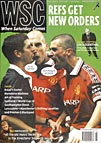 Cris Freddi looks at little Brazil's clash with mighty Exeter City in Rio de Janeiro in 1914
Cris Freddi looks at little Brazil's clash with mighty Exeter City in Rio de Janeiro in 1914
We don’t really chortle at the thought of Brazil taking on a small English club. We understand that these were pioneering days, when a non-League club like Exeter City had not been professional for six years but could field England players of the future in Dick Pym and Jack Fort. A tour of South America then was probably regarded in the same way as a trip to somewhere like Chad or Belize today.
In fact Brazil was only tagged on to the end of the itinerary – originally billed as “The Argentine Tour” – and by the time they got there the whole party had had enough. Violence on the pitch, especially against Racing, and boredom off it left one of their directors admitting, “I’ll be glad when we’ve gone. I’ve had a wretched time and so have the players. We are sick and tired.”
So the Brazilian leg was more of a chore than an adventure, especially when the hassles continued off the pitch: several players were nicked for indecent exposure while sunbathing. City were soon made aware that the standard was higher here than in Argentina, having to work hard to win their first two matches in Rio 3-0 and 5-3.
When they arrived in Brazil, the team watched a junior game in which the players “were all niggers, as black as your hat, and most of them playing in bare feet”. A sign of things to come – but not yet. There were no black players in the team that faced Exeter in their third match. Their best-known forward, Arthur Friedenreich, credited with a “world record” 1,329 goals, was once miffed at being picked for a mixed-race team in a trial match (“They are trying to blacken me”) but looks as white as anyone else in the team photo. For all its reputation as a racially integrated society, the saying “Money can whiten any man’s skin” comes from Brazil.
And money was the main talking point at the time. The Brazilian press made a big thing of their plucky local team being pitted against paid professionals from the strongest football nation on earth, with the implication of a difference in fitness levels. But it’s hard to know how wide this gap really was. Were the City players’ wages any higher than the Brazilians’ boot money (there were allegations later on)? Did they do any more training than their “amateur” opponents who weren’t exactly from the poorest families and had no shortage of free time?
Linked with this perceived gulf in stamina is the old chestnut of radically different styles of play. Again, almost all our information comes from Brazilian papers and makes familiar reading: it was reported that the Exeter players had not been allowed to head the ball on ship (“if they started now they’d be sick at the sight of the ball at the end of three weeks”), and exception was taken to the way they got themselves out of trouble by kicking everything in sight, as well as the use of the shoulder charge.
But again, the facts haven’t been allowed to spoil a good story. Clearly there was robust play on both sides. In their very first match in Argentina, goalkeeper Pym suffered an injury that kept him out of the rest of the tour – and Brazil’s first goal against them was the result of Abelardo barging reserve keeper Reg Loram off the ball for Oswaldo Gomes to drive in the loose ball. Exeter maintained they were simply fighting fire with fire.
Friedenriech, returning after a knock that left blood all over his shirt, made the second goal for Osman, and that was that. In the first half some of the City players were seen walking to the touchline, as a result of which the local press made some naff allegations about professionals giving up because they were losing to amateurs – this about a side who had recovered from two goals down in their previous match. Exeter had probably just had enough of the aggro, or the refereeing (by an Englishman living in Rio), or were just going for a drink of water.
Meanwhile, the Brazilians were heroes to a man: Píndaro and Emmanuel Nery “os extraordinarios defensores”, Rubens Salles among the best centre-halves in the world (how could they know?), Rolando and player-coach Sylvio Lagreca playing “brilhantement”.
But the one-eyed reporting doesn’t stop this being one of the landmark matches. It was the first in which a Brazilian team wore their famous colours of yellow and green (albeit just a band on the sleeves of their white shirts) – and Plaçar magazine lists it as the first ever played by a team regarded as representative of the whole of Brazil. To be honest, I’m not sure why. Various Combinandos Brasileiros had played South Africa in 1906, Argentina since 1908 and Chile as recently as 1913. But anyway there it is, apparently: the first fixture of the biggest footballing country of all.
From the British point of view, the most significant thing about the match is the date. Within two weeks, the First World War had been declared. Within four years, British football could no longer claim to be definitely the best in the world; a million and a half casualties saw to that. Meanwhile, an unscathed Brazil began its rise as a football power, especially when they allowed the young black boys to play. Exeter City joined the new Third Division for the second season after the war and stayed at the League’s lowest level for the next 44 years.
From WSC 157 March 2000. What was happening this month